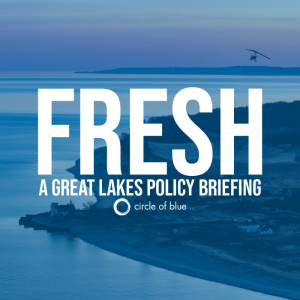Welcome to “What’s Up With Water” – your need-to-know news of the world’s water from Circle of Blue. I’m Eileen Wray-McCann.
Diplomats, business leaders, and environmental advocates have gathered in Egypt for two weeks of international climate talks. The annual high-stakes meeting is called COP27, and is being held in the resort town of Sharm El-Sheikh. In this UN forum, the main agenda items are reducing greenhouse gas emissions, adapting to climate extremes, and compensating poorer countries for damage caused by a warming planet. Water, however, is slowly gaining recognition at the summit. For the second consecutive year a water pavilion will host daily events showing the links between water and climate. Topics include agriculture, biodiversity, finance, Indigenous voices, and adaptation to climate extremes. And that’s not the only platform for water. Egypt’s foreign minister said there will be a presidential roundtable on water security and a day devoted to water issues. COP27 runs through November 18.
As climate change fuels extreme weather, children are bearing devastating impacts. The aid group CARE International says that drought in southern Kenya is causing more students to drop out of school. Based on survey data, the group found that 99 percent of students who left school in September and October withdrew to help their families find food for their cattle herds. Most people in southern Kenya are pastoralists who raise livestock. Teachers say that students who remain in school are often lethargic and hungry. Hunger is also at worrisome levels in Pakistan, where the country is still reeling from this summer’s massive monsoon flooding. The World Health Organization notes high rates of acute malnutrition and a rise in cases of malaria in Pakistan. There is limited access to safe water and sanitation after a flood season that inundated nearly one-third of the country. Aid agencies worry that Pakistan’s post-disaster struggle is being forgotten among competing international priorities.
In the United States, the iconic Mississippi River has fallen to near-record lows, and a group of Mayors in the river basin is seeking federal assistance. The Mississippi River Cities and Towns Initiative has policy proposals that the mayors will present to the federal government. According to the ag news agency DTN, the list includes payments to farmers for not irrigating their crops and expanded access to FEMA disaster funds. The list also suggests releasing more water out of upstream reservoirs to aid in river navigation. The Mississippi River is the primary highway for Midwest grain exports, but low water is crippling commercial traffic. Ninety percent of the Mississippi’s lower basin is in some stage of drought. Barges face delays, weight restrictions, and the risk of running aground. Paul Rhode is the vice president of the Waterways Council, a lobby group for river navigation. He said the low water contributes to the supply chain bottlenecks that have afflicted the world’s economies in recent years. If drought conditions continue, he said this “could be an unprecedented disruption of the inland river supply chain.”
And that’s “What’s Up With Water” from Circle of Blue, where water speaks. More water news and analysis await you at
circleofblue.org. This is Eileen Wray-McCann – thanks for being here.





